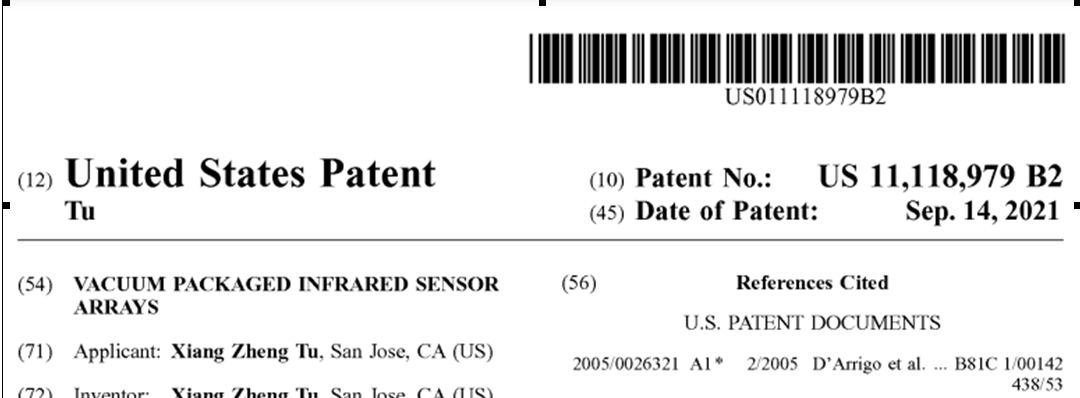光开关矩阵的诞生:从设计到美国专利
Tu Xiang Zheng (涂向真)
我的一项用于全光通信的MOEMS光开关矩阵设计获得美国发明专利,专利名称:Method for making optical switch array,专利号:6,773,942,授权日期:August 10, 2004。
这项设计的过程是漫长的,艰辛的,充满挑战,有时还富有戏剧性。事情的起因,要从我在美国宾州大学电子工程系当访问教授谈起。我承担的研究课题涉及到光学测量,不少时间要在暗室中度过。光学实验室设在宾大Moore大楼的一层,与世界上第一台全数字电子计算机“ENIAC”的展室相对。我进出实验室都要经过一条L型的通道,实际上,通道已经改装成博士生候选人的办公室。到宾州大学读博士的学生要试读一年,准备资格考试,考试合格的学生被正式录取为博士生,录取的学生由博导教授另外安排办公室,未被录取的学生就要离开宾大,另找出路。
有一次,我在实验室做测量,把室内灯全关了,正用红外相机拍摄光波相干的干涉条纹。突然,实验室的门被打开了,射进一道刺眼的亮光。我一瞥,一位学生走进来,连连向我道歉,说他不小心把书架撞倒了,倒在实验室门上,把门撞开了。
一次生,二次熟,此后这位学生每次见到我都要跟打招呼,还主动和我聊天。他说,他来自南斯拉夫,父亲是工程师,母亲是教师,来美国学习主要靠他的一位在德国工作的叔叔资助。他叫Smiweiqe,学的是光学工程,对光学实验感兴趣,想要我给一个机会,看我做光学实验。
我满足了Smiweiqe的要求,让他看了我做实验的全过程,还让他看我拍的干涉条纹照片。他看后说,这是一组等厚干涉条纹,是由两块干净的镜片紧紧压叠,两镜片间的空气层就形成空气薄膜,用水银灯或纳灯作为光源,就可以观察到薄膜干涉现象。如果镜片表面不很平,所夹空气层厚度不均匀,观察到的将是一些不规则的等厚干涉条纹,通常是一些大大小小的同心环.若用很平的镜片,则会出现一些平行条纹。他还说,条纹很清晰,很光滑,镜片一定很光亮。然后,就在实验台上找镜片,找了半天也没找到,就问我,我说那就是,指着一根单模光纤和一块微机械加工的硅片,他显得很茫然,睁大眼睛盯着我。我就给Smiweiqe解释,这不是一块普通的镜片,而是硅片内部的一个<111>晶面,是通过各向异性腐蚀(110)硅片形成的。Smiweiqe点了点头,似乎有所领悟,其实,他并不完全知道其中的奥妙。
这块<111>晶面,高50微米,宽100微米,只有针尖那么大。这么微小的镜子在日常生活中没有任何用处的,但用它构建高度密集的微型反射镜矩阵,并配合直径8微米的单模光纤矩阵,就成了以光速传送信息的通信网络,把整个地球缩小成客厅,会议室,电影院,体育馆,赛马场,人们之间没有空间距离,相会交流没有任何阻隔。于是,又有一个发明的梦想在我头脑中生成,尽管这只是梦想,与现实还有很大差距,也正是还有差距,才会产生发挥自我的决心,完成理想的欲望和永不放弃的坚持。
我带着这个梦想进了新泽西州的Rutges大学,在那里我读到一篇论文,是新泽西理工学院的两位教授发表的,他们做了一面直立在硅片表面的(111)晶面微型反射镜。新泽西理工学院在纽瓦克,离我所在的Rutges大学的Busch校园很近,我总想找个机会去参观一下。委托我开光纤传感器检漏产品的公司的汤和羌得知我的想法后,专门为我安排了一次学术交流活动。
羌开车送我到新泽西理工学院,经他介绍,与两位教授见了面。这两位教授也研究微光机电系统(MOEMS),主要开发微镜组件。我也作了自我介绍,着重介绍我研发的光纤传感器。交流结束后,两位教授领我们参观他们的实验室。他们的实验室不大,不是做微电子产品的无尘室,只能做一般的化学实验。在我的要求下,他们让我在显微镜下观看了他们制作的(111)晶面微型反射镜。
两位教授的数据进一步证明,各向异性腐蚀硅片产生的(111)晶面具有原子级的光滑度,反射系数也足够大,完全可以用作反射镜,这与我的认知是相同的。但是,要制作成具有开关功能的反射镜矩阵,对他们说来,要解决的问题还很多,路途还很遥远,因为他们还没有考虑反射镜的移动问题。
我开始光开关矩阵的设计,在我面前挡道的是如何让(111)晶面垂直移动。我想了好多个办法,都由于工艺流程过于复杂,设备要求过于苛刻,最后一个个被我放弃。我化了大半年的时间,查遍文献,绞尽脑汁,仍然是无法可想,无计可施,“移动”的问题就像是一座大山,把我的前进之路堵得严严实实,我痛苦不堪,不得不暂时在梦中不断探索。
足足有两年的时间,光开关矩阵就像幽灵,在我脑海中时隐时现,时时刻刻提醒我,不要停留原地,要继续前进。有时还督促我,鞭策我,要我快马加鞭,只争朝夕,努力攀登科技高峰。
有一次,在我查阅文献时,看到一篇文章报道:在硅片的多孔硅表层上,可以进行外延生长,形成硅单晶层。这真的是“踏破铁鞋无处寻,得来全不费功夫”,我终于找到梦寐以求的锐利武器,攻克光开关矩阵的难关几乎不成问题。我对多孔硅研究得比较透,而硅外延生长是初进研究所所做的工作,只是一直没有在多孔硅上生长外延层的经验。
解决了(111)晶面垂直移动的难题后,光开关矩阵的设计就算是大功告成了。由于设计方案新颖,技术路线独特,实施工艺流程成熟,我专利申请顺利通过美国专利局的审查,授于发明专利权。
我设计的MOEMS光开关矩阵属于光路遮挡型,矩阵由N×N的微镜组成,用来连接N条输入光纤和N条输出光纤。微镜和光纤在同一个平面上,微镜有原位和上移两种位置,相应于开和关两种状态。微镜的上移是在静电力的作用下产生的。当某一微镜上移处于开状态时,由其对应的输入光纤射出的光束经其反射而进入其对应的输出光纤,从而实现任意输入光束耦合为输出信号。
MOEMS光开关的应用,可以从小型光交叉连接直到大型光交叉连接。在光通信网络中,光开关矩阵具有光路选择,多条光纤线路的交叉互连,上下光路及对故障光纤线路进行旁路等重要功能,是光通信网络中许多设备的关键光器件。
MOEMS光开关既有机械式光开关的低插损,低串扰,低偏振敏感性和高消光比的优点,又有波导开关的高开关速度,小体积,易于大规模集成等优点。MOEMS光开关与光信号的格式,波长,协议,调制方式,偏振,传输方向等均无关,与未来光网络发展所要求的透明性和可扩展等趋势相符合。




